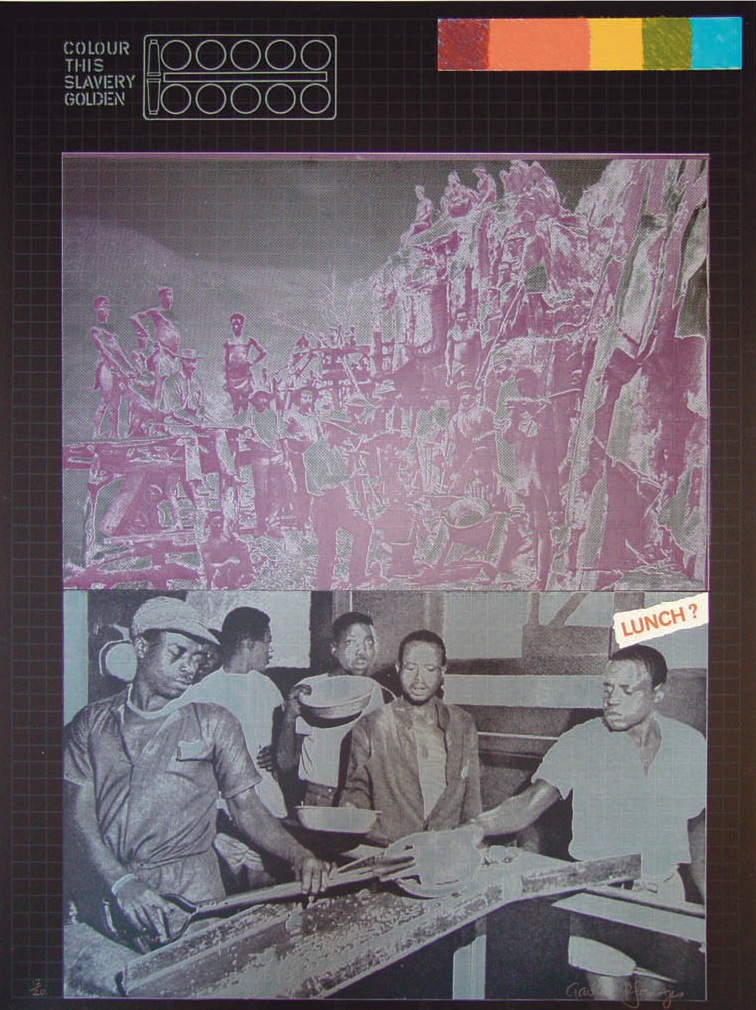After graduating from the Michaelis School of Fine Art in Cape Town in 1969, Coloured art student Gavin Jantjes left the country to study further at the Hamburg Art Academy in Germany. There he was faced by a shocking revelation: His new fellow art students knew so little about the South African situation of racial segregation that in most cases they understood apartheid as a benevolent system of control over what was believed to be the spreading influence of communism in Africa. To the conservative German population, the self-determination of the African people was not held to be a viable proposition.
Looking back Jantjes recalls, “When curious young Europeans asked about my home, I often recognized the same ignorance about apartheid in their questions as the white South Africans who had not made that daring step across the dividing line into a black township.”
To counteract this lack of knowledge, Jantjes decided to embark on a series of prints about the grim reality of daily life for black people in the country of his birth. In the United States, artists like Robert Rauschenberg and Andy Warhol had been using the hitherto industrial technique of photo silkscreening to make mass-produced art since the early sixties, and to Jantjes the use of this alluring photographic technique seemed ideally suited to the work he had in mind. A South African Colouring Book (1974–75) was titled to suggest early learning, or painting by numbers, as well as the South African state’s obsession with categorizing every aspect of life by color.
Using source material from diverse South African and foreign press archives and photographer Ernest Cole’s House of Bondage, Jantjes’s eleven many-layered screen prints with titles like Colour This Slavery Golden and Colour These People Dead reflected aspects of police action, like the 1960 Sharpeville shootings, when police opened fire on a peaceful protest against the pass laws, killing sixty-nine, and other inhumane aspects of apartheid. Jantjes’s prints were chosen by Joseph Beuys to show in his space at the prestigious exhibition Documenta 6 (1977) in Kassel and were later included in Okwui Enwezor’s critically acclaimed exhibition The Short Century: Independence and Liberation Movements in Africa 1954–1994, which opened at the Villa Stuck Museum in Munich in 1999 and subsequently toured venues such as P.S.1 Contemporary Art Center in New York.
Had he remained in South Africa, Jantjes doubts that he would have dared to directly criticize the state in the direct, uncompromising way that his prints did. Made in the silent years before the idea of resistance through art took hold throughout South Africa, Jantjes’s lacerating A South African Colouring Book remains important for the light it sheds on the dark past.

Colour This Slavery Golden A South African Colouring Book (Folder with eleven prints) 1974–75
Silkscreen print with collage
45 x 60 cm each
Published by: Gavin Jantjes
© Gavin Jantjes

Classify This Coloured A South African Colouring Book (Folder with eleven prints) 1974–75
Silkscreen print with collage
45 x 60 cm each
Published by: Gavin Jantjes
© Gavin Jantjes

Colour These Blacks White A South African Colouring Book (Folder with eleven prints) 1974–75
Silkscreen print with collage
45 x 60 cm each
Published by: Gavin Jantjes
© Gavin Jantjes

Colour These Workers Sold Out A South African Colouring Book (Folder with eleven prints) 1974–75
Silkscreen print with collage
45 x 60 cm each
Published by: Gavin Jantjes
© Gavin Jantjes